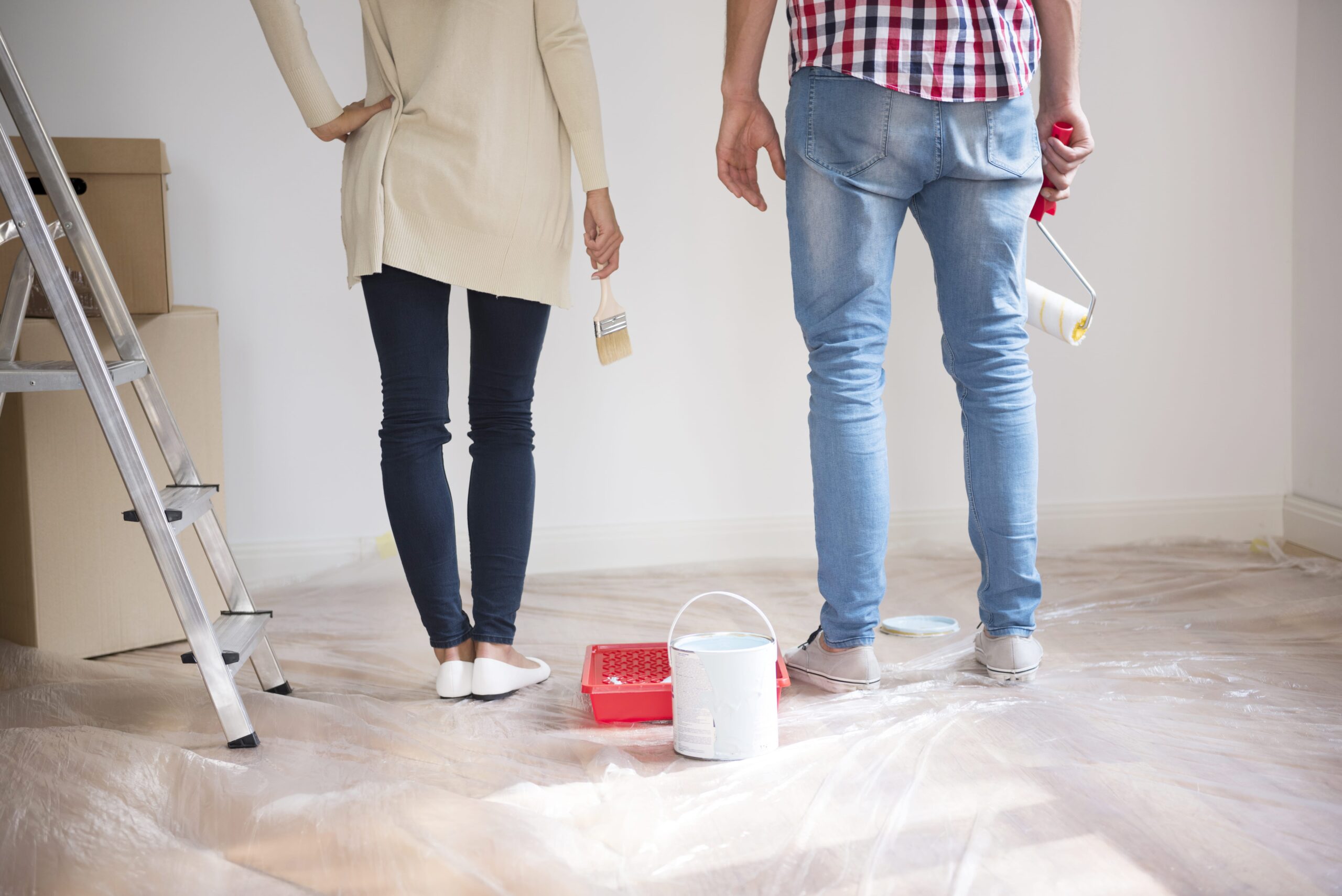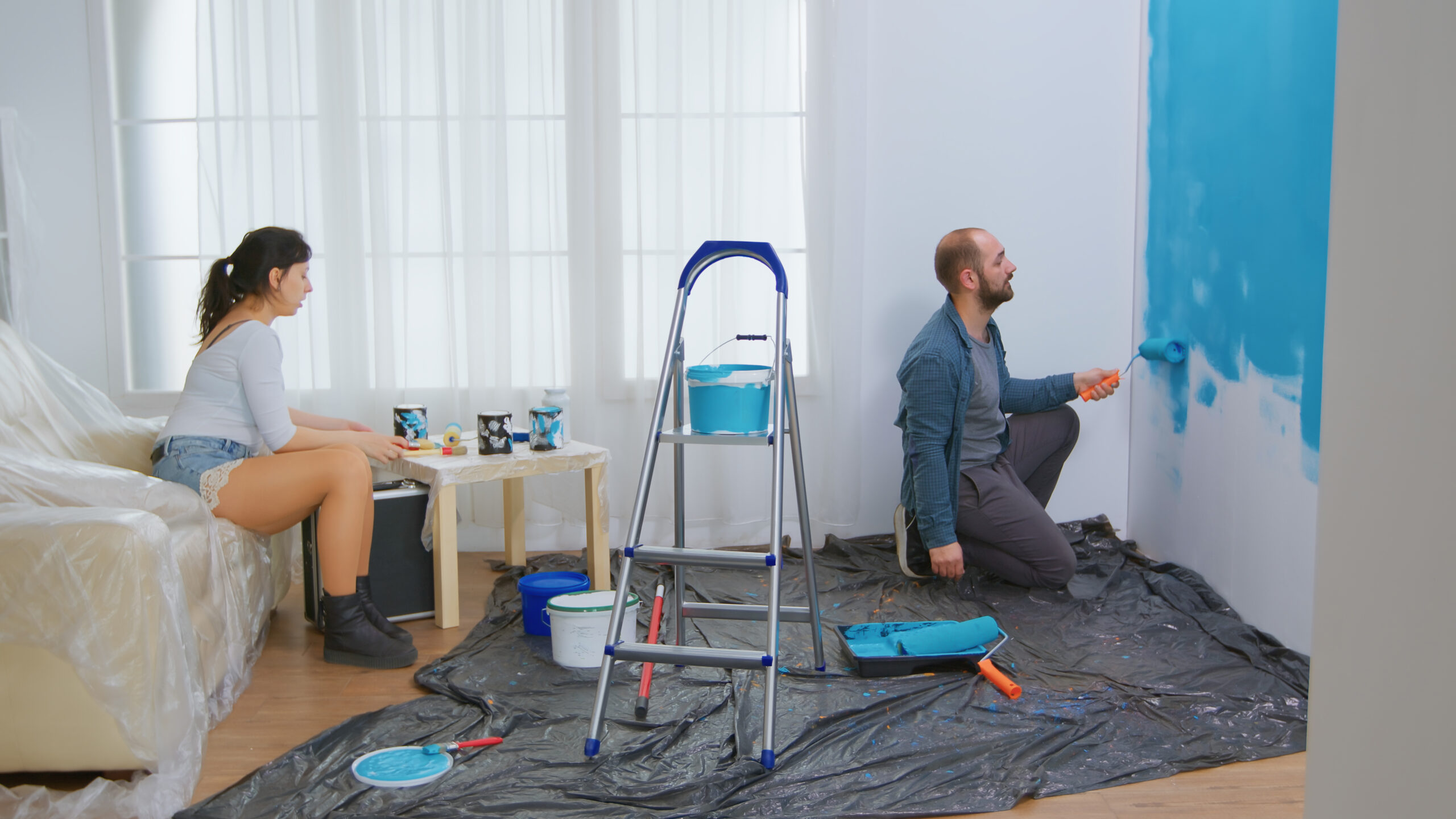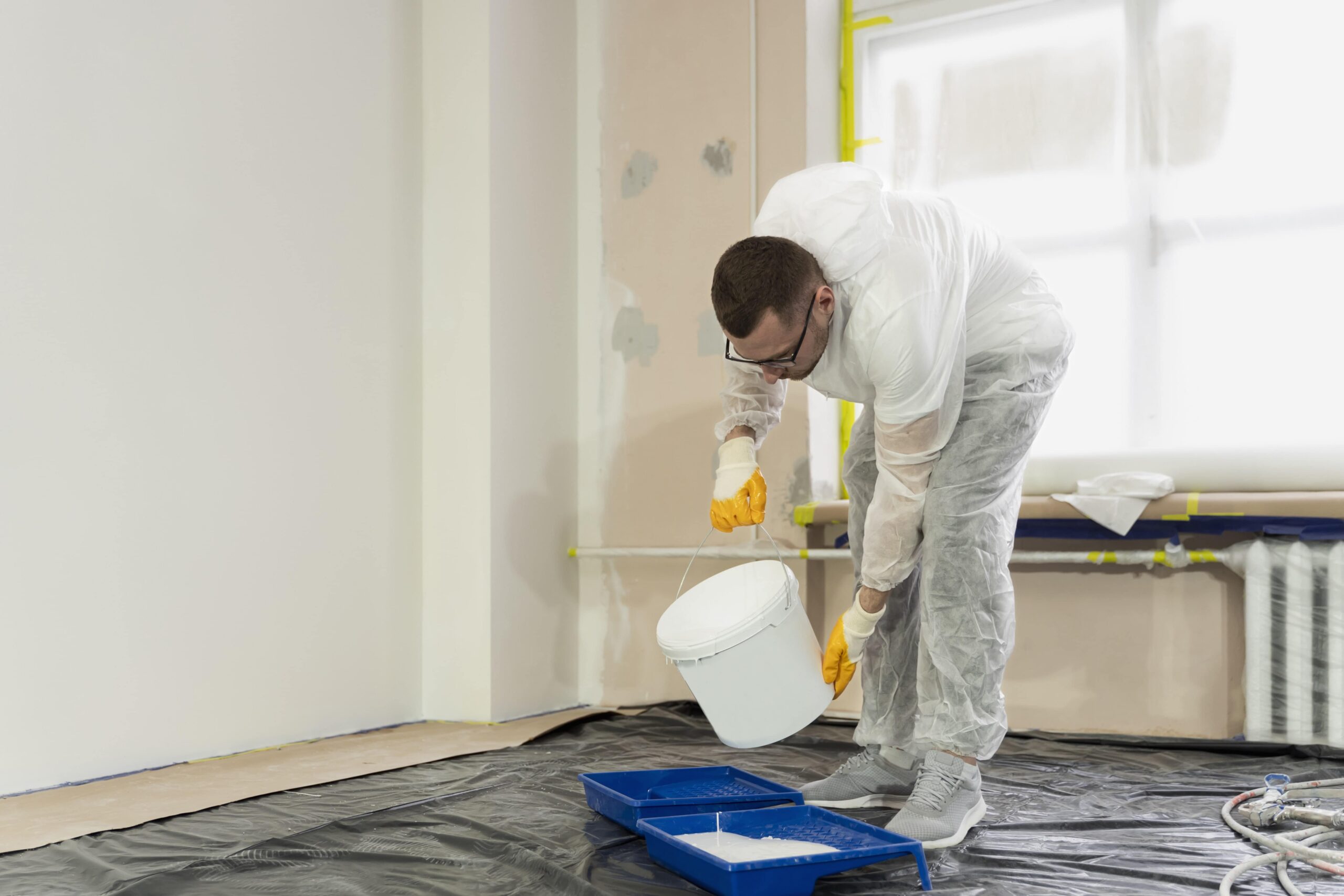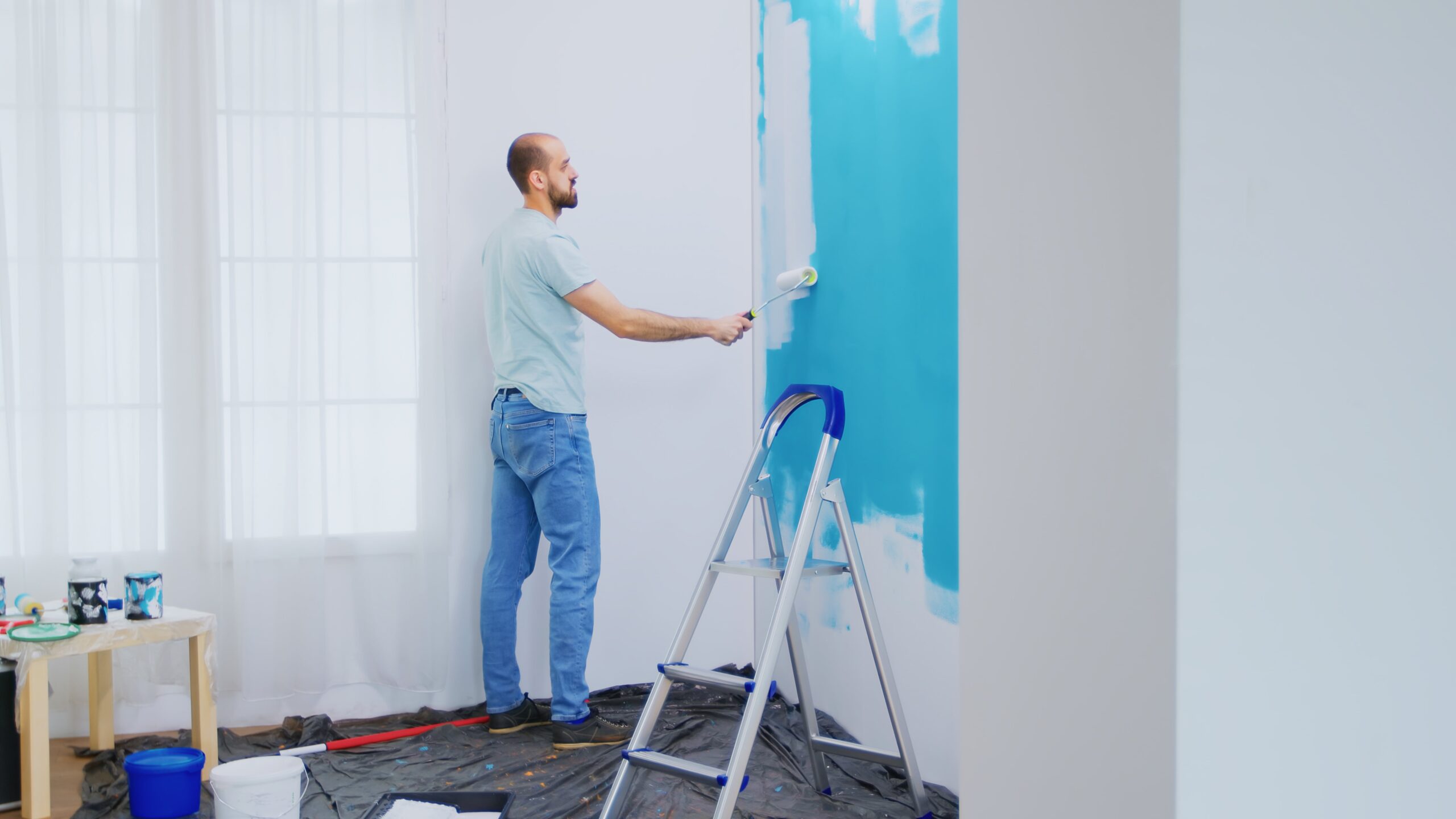
Should You Paint Before or After Flooring? 8 Key Factors to Consider
When renovating or remodeling a home, one of the most common debates is whether to paint before or after flooring. While it may seem like a small detail, this decision can significantly impact the outcome of your project, both in terms of aesthetics and practicality. Whether you’re working on a DIY project or hiring professionals, knowing the painting vs flooring order can save you time, effort, and money.
Table of Contents
Key Takeaways
✔ Painting before flooring protects new floors from potential damage like splatters or smudges, ensuring your investment stays pristine throughout the painting process.
✔ Painting first allows for better flexibility and faster access to walls and trim, enabling you to complete the job more efficiently without worrying about masking off new floors.
✔ Installing flooring first ensures precise alignment of trim and baseboards with the final floor height, resulting in a cleaner, more polished finish.
✔ Painting after flooring minimizes the risk of paint damage during floor installation, protecting your freshly painted surfaces from scratches or stains.
Should You Paint Before or After Flooring?
It’s generally best to paint before installing new flooring, which helps prevent splatters and allows painters to work freely on walls and trim. For those moving to Los Angeles from New York, fresh paint can boost your home’s appeal before listing it or preparing for the move. This approach also eliminates extra protective steps and reduces the need for post-flooring touch-ups.
However, there are instances when installing flooring first may be a better choice. For example, if you’re concerned about the alignment of baseboards and trim with the final height of your flooring, it’s often better to install the floor first and then paint the trim afterward. This also helps ensure that your freshly painted walls aren’t damaged during the floor installation process.
Answering the question: should you paint or install flooring first, depends on several factors, such as the type of flooring being installed, the layout of the space, and personal preferences. Each project is unique, so it’s important to weigh the pros and cons in your specific situation to make the best choice.
Paint First – Why It Might Make Sense
Many homeowners and professionals prefer to paint before or after flooring, particularly when dealing with large or open spaces. Painting first allows for greater flexibility and fewer worries about damaging the newly installed flooring. Here’s why this might be the right choice for you:
1. Protect New Flooring from Paint Splatter
One of the most significant advantages of painting before or after flooring is protecting your floors from paint splatters, drips, or smudges. Even with protective drop cloths and masking tape, accidents can happen, and paint splatters on your new floors can be a nightmare to clean up—especially on hardwood, carpet, or tile.
New floors are expensive, with costs ranging from $1,530 – $4,860 on average. Knowing this, it’s essential to protect them during the painting process. Choosing to paint walls before flooring ensures that any mess made during the painting job falls onto the subfloor, rather than your beautiful, freshly installed floors.
- Prevents Damage: Flooring materials like hardwood, laminate, or vinyl can absorb paint, resulting in permanent staining.
- Less Clean-Up: When you paint before or after flooring, you avoid the time-consuming clean-up process that can follow paint splatter.
2. Easier Access for Painting Walls and Trim
Painting your walls before installing flooring gives you full access to the walls and trim without having to worry about taping off your new floors. This makes the painting process faster and more efficient.
- Free Movement: With no flooring in the way, you have greater flexibility to move freely throughout the room.
- No Need to Mask Flooring: Painters can work faster and more efficiently, as they don’t need to spend extra time carefully masking or taping around the edges of the new floor.
This can be especially useful if you’re working in a room with intricate angles, corners, or trim. When you paint walls before flooring, you can work quickly without the restrictions that flooring may impose.
3. Avoid Touch-Up Hassles Later
Another key advantage of painting before or after flooring is that it reduces the likelihood of having to do touch-ups once the floor is installed. When you install flooring before painting, there’s always the risk that some paint will be splattered or smudged during the floor installation process, especially near the baseboards or trim.
- Eliminates Scraping of Fresh Baseboards: It’s not uncommon for paintbrushes or rollers to scrape the edges of freshly laid baseboards or floors, leaving behind unsightly marks.
- Saves Time: Touching up paint after flooring installation can delay the final stages of your renovation, adding unnecessary time to the project.
Choosing to paint walls before flooring minimizes the risk of these headaches, saving you time and effort in the long run.
4. Cost Savings on Labor
If you’re hiring professional painters, they may charge less if they don’t need to carefully navigate around your newly installed flooring. Less prep work means faster job completion, which can translate to cost savings.
- Faster Job Completion: Painters can complete their work more quickly if they don’t have to worry about covering new floors or moving obstacles out of the way.
- Fewer Protective Measures: With no flooring in place, there’s no need for extensive protection measures like drop cloths or tape, reducing the overall cost of the job. Additionally, it protects the painters, considering chemical hazards exist when a worker is exposed to any form of chemical substance—whether solid, liquid, or gas—within the workplace.
Overall, painting first is often a more efficient and cost-effective option when working with professional painters.
Flooring First – When It’s a Better Option
Should you paint or install flooring first? While painting before or after flooring has many advantages, there are also scenarios where installing flooring first is the smarter choice. Here are several reasons why flooring first might work better for your project:
1. Baseboard and Trim Alignment
When deciding between painting before or after flooring, it’s important to think about how your baseboards and trim will align with the new floor. Installing flooring first ensures that the trim is cut precisely to the finished height of the floor.
- Floor Height Impacts Trim: If you paint before installing flooring, your baseboards may not align with the final floor height, especially if you’re working with thicker materials like hardwood or carpet.
- Trim Fit: Installing the floor first gives you an accurate guide for cutting and placing your trim. This leads to a cleaner, more polished look.
2. Easier Touch-Ups After Flooring Installation
Sometimes, flooring installation can cause damage to walls, trim, or baseboards, especially if you’re working with adhesive or heavy materials. If you paint after installing flooring, you can easily make final touch-ups to any areas that were affected during the flooring installation.
- Minimize Paint Damage: Since flooring installation tools and materials can scratch or mark painted walls, flooring first ensures that you won’t have to deal with touching up paint after the floors are in.
- Final Adjustments: After the floor is in place, you can take a step back and make any necessary adjustments to the paint, ensuring a perfect final look.
3. Protecting the Paint from Floor Installation
When installing flooring—particularly heavy materials like tiles or hardwood—there’s always a risk that tools, adhesive, or even installers could accidentally damage freshly painted surfaces.
- Flooring Can Scratch Paint: Tools used during the floor installation process, such as trowels, saws, or hammers, can easily damage painted walls or trim.
- Avoid Paint Damage: By waiting until the floor is installed, you can ensure that your fresh paint job remains intact.
If protecting your newly painted surfaces is a priority, it may make more sense to install flooring first and leave painting as the last step.
4. Paint Color Coordination with Flooring
The color of your floor can significantly affect the overall aesthetic of the room. By installing flooring first, you’ll have a better idea of how your new paint will look with the final flooring.
- Better Color Matching: If you paint before flooring, the final look may not match your expectations because the lighting and texture of the floor haven’t been factored in.
- Coherent Design: Installing the floor first lets you choose a paint color that complements the floor, ensuring a cohesive and harmonious design.
This is especially important for large or open spaces where the flooring plays a significant role in setting the tone for the room.
Why You Need to Trust the Pros for Expert Painting
When it comes to decisions like painting vs flooring order, many homeowners may feel tempted to take on the task themselves. However, professional painters bring invaluable expertise that ensures the job is done right and protects your investment. Here are reasons why trusting the pros is crucial when deciding whether to paint walls before flooring or vice versa:
1. Professional Painters Have the Right Tools for the Job
One of the main advantages of hiring a professional is their access to specialized tools and equipment that ensure a clean, efficient, and flawless result. When you trust the professionals, you ensure the job is done efficiently, no matter if you paint before or after flooring.
- High-Quality Equipment: Professionals have industrial-grade brushes, rollers, and sprayers that are designed for precision and coverage.
- Protective Gear: They come equipped with drop cloths, painter’s tape, and masking paper to protect your floors and furniture during the painting process, which is especially important when considering paint before or after flooring.
- Efficient Application: The pros know how to cover a large area quickly and evenly, preventing over-application, which can lead to visible streaks or missed spots.
2. Expertise in Painting Surfaces and Materials
Choosing whether to paint walls before flooring or install flooring first requires an understanding of different surface types and the correct paint application techniques. Here’s why the pros are equipped to handle these nuances:
- Surface Preparation: Professional painters are adept at preparing various surfaces, ensuring they are smooth and clean for optimal paint adhesion.
- Specialized Paints: Depending on your project, the pros may recommend certain types of paint for specific materials such as drywall, wood, or metal.
- Expert Color Matching: Professionals can help you choose the right colors that complement the new flooring, making the process of deciding whether to paint before or after flooring easier and more aesthetically pleasing.
3. Time-Saving and Reduced Risk of Mistakes
While DIY projects can be rewarding, they can also take much longer than expected, especially when it comes to painting large areas. When deciding should you paint or install flooring first, consider the time and energy you’ll save by leaving the job to the professionals, especially for larger spaces or intricate work. Here’s how hiring the pros saves time:
- Faster Completion: Professional painters have the skills and experience to get the job done quickly and efficiently, helping you stick to your renovation timeline.
- Risk-Free Execution: Mistakes such as uneven coats, paint drips, or incorrect color choices can cost you more time and money in the long run. With a professional, you can avoid these common mishaps.
- Reduced Clean-Up: A professional painter will ensure the space is properly prepped, painted, and cleaned, saving you hours of labor after the job is completed.
4. Protecting Your Investment
When you decide whether to paint before or after flooring, one of the most important considerations is protecting your home’s value and the quality of your flooring investment. Professional painters ensure your floors remain undamaged, no matter the sequence you choose.
- Floor Protection: Professionals know how to protect your floors from any potential damage that may occur during the painting process, especially if you paint walls before flooring.
- Long-Term Results: Quality painting jobs done by experts provide a durable, long-lasting finish, saving you from having to re-paint or re-touch frequently.
- Minimizing Floor Damage: If you decide to paint before or after flooring, the pros can guide you on the best protection methods to prevent damage or scuffing to your new floors.
5. A Seamless, Professional Finish
The final result is one of the key reasons why many homeowners choose to hire professionals. In the decision of whether to paint before or after flooring, professionals will provide the quality and precision needed for a flawless finish. Here’s what you can expect from an expert paint job:
- Smooth and Even Coats: Whether you decide to paint walls before flooring or after, professionals ensure every inch of your walls is evenly coated with no visible lines or imperfections.
- Neat Edges: Professionals will expertly cut in edges along the baseboards, ceiling, and trim, leaving a clean, sharp finish that DIY painters often struggle to achieve.
- Attention to Detail: Professionals take the time to address every nook and cranny of the space, ensuring that no areas are missed, and the overall look is cohesive.
5 Things to Look for in a Painting Contractor
Choosing the right painting contractor can make all the difference in the quality and longevity of your paint job, especially when considering painting vs flooring order. To help you find the best fit for your project, here are 10 essential things to look for when hiring a painting contractor:
- Experience and Reputation: Look for contractors who have extensive experience and a solid reputation in the industry. Positive reviews, referrals, and a portfolio of completed projects are key indicators of their expertise and trustworthiness.
- Proper Licensing and Insurance: Ensure that the contractor is licensed to operate in your area and carries adequate insurance coverage. This protects you from potential liabilities during the job, such as damage to your property or accidents on-site.
- Portfolio of Past Work: Request a portfolio of the contractor’s previous projects to evaluate the quality and range of their work. A strong portfolio will demonstrate their skills and attention to detail.
- Detailed Written Estimates: Get a clear, itemized estimate in writing. This should include costs for materials, labor, preparation, and any additional services. A detailed estimate helps you avoid unexpected charges later on.
- Warranty and Guarantee: A reputable contractor should offer a warranty or guarantee on their work. This provides assurance that if any issues arise after the job is completed, they will address them promptly without additional costs to you.
Frequently Asked Questions (FAQs)
When tackling a painting project, it’s generally best to start at the top and work your way down. Begin by painting the ceiling first to avoid any drips and splatters from the ceiling paint on freshly painted walls. After that, move on to the walls. Once the walls are done, finish with the windows, doors, and skirting boards.
It’s typically recommended to paint the ceiling before the walls. This order prevents the ceiling paint from dripping onto your freshly painted walls, creating a smoother, cleaner look. By painting the ceiling first, you avoid having to fix unwanted paint splashes or drips later, which could slow down your progress and require extra touch-ups.
The five stages of painting, in a logical order, include: (1) design, (2) draw, (3) block in, (4) refine, and (5) finish. While this is applicable more to art painting, it can still guide your approach in home painting projects, ensuring every step is well-executed.
To paint your home efficiently, follow a logical progression:
- Start with the ceiling to ensure any paint splatters are easily covered by subsequent coats.
- Next, tackle the trims, which include the corner mouldings of doors, windows, and ceilings.
- After the trims, do the cut-ins where walls meet ceilings, doors, windows, and floors. This step ensures sharp, clean edges.
- Finally, move on to painting the walls once all other details are complete.
Before you begin painting, priming the surfaces is essential. Primer is particularly important for new walls or when switching from dark to light colors. It also helps paint adhere better, resulting in a smoother and longer-lasting finish. Priming before painting helps achieve more even coverage and prevents the need for extra coats, saving you time and paint in the long run.
Ready for a Makeover? Let Our Experts Paint Your Vision!
For professional and reliable painting services, look no further than Southbury House Painting Experts. As the leading painting contractor in Southbury, CT, we specialize in both interior and exterior painting. Our team understands that a successful painting project goes beyond just the final coat—it’s about proper surface preparation and using the right techniques to ensure a long-lasting, beautiful finish.
Ready to get started? Contact Southbury House Painting Experts today for a consultation.



